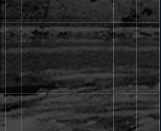|
MF:
Shoes are a dominant element in the series you call Atrabiliarios,
an archaic Spanish word whose Latin roots, atra bilis, combine
profound mourning with bile, or rage. You `buried’ the shoes,
many of which lack their mate, in wall niches, which you then covered
with translucent animal fiber and closed with surgical thread. The
process itself, one of humble care and profound homage, calls up
ancient customs; the effect on the viewer is one of searing loss.
The shoes are at once homely and familiar, but because they are
sealed off and their outlines are indistinct, they seem to be fading
before our eyes into another realm.
DS: It is more and more difficult to find the diffuse boundary
between the intimate and the political. The grief of the relatives
of desaparecidos—like all grief—is of an intimate nature,
but when the essence of these events is political, I believe the
society must acknowledge it. I am interested in showing that social
injury, its collective character.
The direct witness to forced disappearance is not here, cannot tell
us his experience. My work is about the impossibility of seeing,
of knowing, and of communicating.
So to return to your comment--yes, shoes are an important image
of the Holocaust, as you must know. The history is different, but
the resonance is similar.
MF: You’re referring to the shoes in Yad Vashem.
DS: Yes.
MF: In La casa viuda [The Widowed House, 1992-94]
we see how pervasively intimate and domestic the violence has become.
In La casa viuda I, a found door stands alone; pushed against it
is a small, low, distressed wooden table, partially wrapped in fragments
of lacey white cloth--doily? tablecloth? curtain? dress? nightgown?
glove? The piece calls up absence and wreckage and bandaging (even
surgery, owing to prominent stitching), but it also makes a declaration:
There was a whole gregarious family living here, they received their
friends with style and elegance. The piece is extremely succinct,
yet it hits you with many associations all at once.
DS: This work refers to forced displacement. The displaced
person is an extreme and paradigmatic figure for our epoch, the
figure who has broken the connection to his birthplace and so lacks
a place of his own. He is the immigrant no one wants to be close
to, who is rejected by everyone.
Humans are spatial beings, we need a place to eat, a place to write,
to think, etc. It is impossible to disassociate space from human
experience. The Casa Viuda [The Widowed House] series refers
to those millions of human beings who have no space.
I am also interested in the image of the artist as a displaced person.
An artist does not occupy a central place in his work, the center
is inhabited by the experience of another being.
|

Atrabiliarios, 1993
Wall installation with plywood, three shoes, cow bladder and surgical
thread in 2 niches
31.8X51.4 cm
Courtesy
Alexander and Bonin, New York
|


